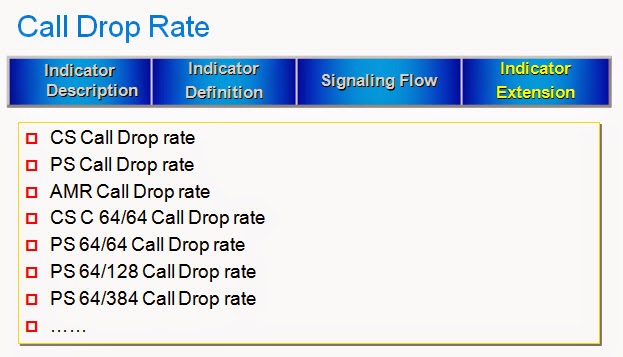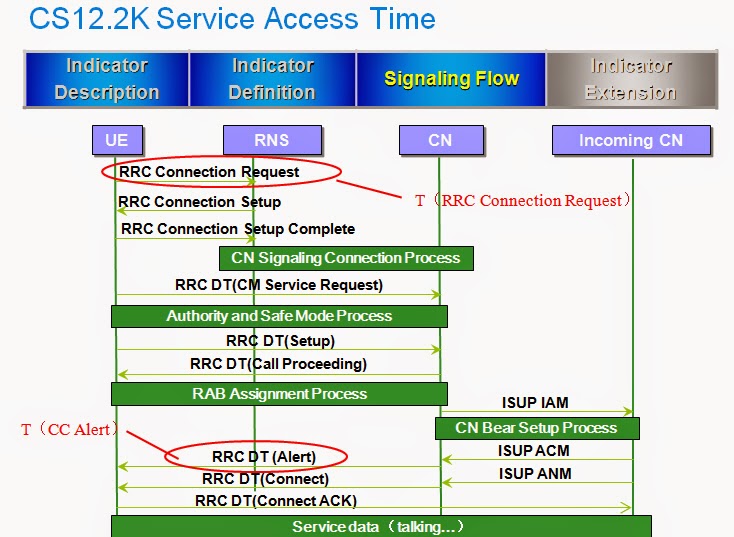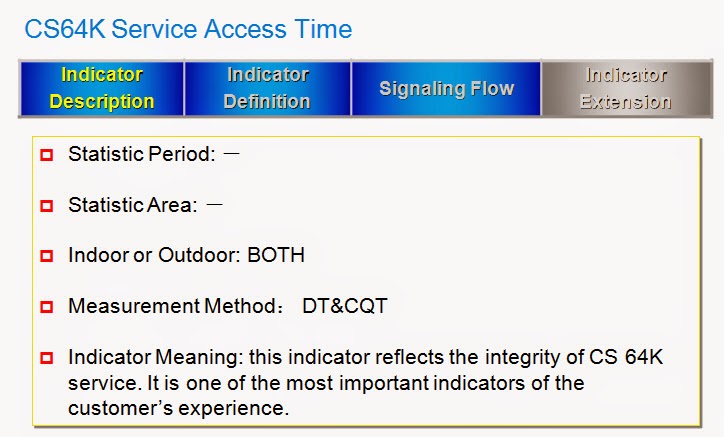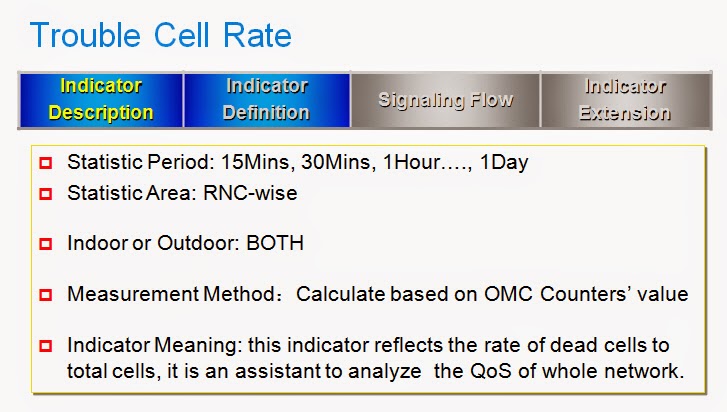KPI Overview
- (RAN) Mobile Network Element Management System is Element Management System of operation and management for one or more NEs. (FM, PM, CM)
- Performance Monitor (according to the importance and usage):
- KPI
- PI: Performance Indicator
- SPI: statistical performance indicator: with statistical rule such as call completion rate greater than 95%.
- Customized performance index
- KPI Monitor Tools:
- Performance management
- Fault Management
- Configuration Management
RAN KPI Category
Coverage Probability
Coverage Probability
RRC Establishment Success Rate
RRC Establishment Success Rate
KPI Optimization
KPI Optimization Process
Radio Access Success Rate
- Radio access success rate = RRC establishment success rate × RAB establishment success rate
- This formula indicates that RRC establishment rate and RAB establishment rate need to be considered in the background statistics.
- RRC establishment success rate = Number of successful RRC connection setup times of each cell / Number of RRC connection request times of each cell × 100%
- Note: related with services (RRC connection)
- RAB establishment success rate = Number of successful RAB establishment times / Number of RAB establishment attempts × 100%
- RAB establishment success rate is categorized by service.
Access Success Rate Analysis Process
Access Failure Caused by RAB Establishment Failure
- There are two restraints in RAB establishment process. One is RB establishment which is the UE configuration process (usually no problems occur in this process); and the other is radio link re-configuration process in which NodeB links are configured. Failures often occur in the latter process. The usual causes for these failures include radio link re-configuration preparation failure (it occurs when problems occur in NodeB resources.), and radio link re-configuration cancellation (it occurs when problems occur in RNC internal resources or process). Another factor may also cause RAB failures, that is, when the load of a cell is relatively heavy, RNC sends out a reject command via admission control.
Call Drop Optimization
Handover Success Rate Optimization
- Factors affecting handover success rate
- Handover area is too small, so that UEs have not enough time to complete handover.
- Handover parameters are wrongly set, so that neighbor cells cannot be added or deleted timely, or causing ping-pong handover.
- Neighbor cells are not configured. This may cause damage to the network, not only directly causing call drop, but also brings extra interference towards the network.
KPI monitor
Resource KPI monitor
- One reason for resource limitation is number of 3G user increase, and operator changing fee decrease also lead to the increase of average erlang. The other reason is the strategy for design is focus on user feeling and KPI but not system capacity. For example HK user average Erl cold be up to 0.5E.
- Single user erlang could be 0.45erl on BH:
- Resource KPI and threshold.
- Resource KPI mainly include DL power, UL capacity, code resource and CE resource.
DL power monitor
DL power monitor
- Modify reserve HSDPA power according to system algorithm.
- MinHsdpaPower(MinHspaPwrRto)+NoHsPower >Node B admission threshold(MinHsdpaPower stands for HSDPA reserved power ),DL congestion control will start (downgrade DL DCH rate)。MinHspaPwrRto default value is 20%.
DL power monitor
- Because high load cell often be with high admission failure, normally we should fast downgrade to release radio resource ASAP. Avoid handover user could not handover in the cell then call dropped.(this action is only take effect in cell with much more PS users, if all users in the cell is in CS service. It will not take effect).
- Through decrease DL Eb/No could lead to reduced congestion. While we need detailed evaluation to avoid some other bad effect. Table showed record for the modification, and can be consider as the reference. ZTE engineering experience showed downgrade Eb/No for 13.6K signaling channel could reduce TCP limitation effectively, while the performance of access will not be affect so much.
UL capacity monitor
- Call drop rate increasing not means UL capacity limitation, but call drop increasing is the most common scene for limitation. Because call drop rate is most cared KPI, and be observed every day.
- RTWP increasing is the most directly representation for UL limitation, while sometimes reason for RTWP increasing could be external interference. And it’s hard to eliminate this reason.
- Erlang is determining factor for UL limitation either. There are many factors related to the erlang of a cell. Normally we should care for cell capacity, if erlang in a cell exceed 20 erlang in BH.
- UL Power control parameter modification. The quality of users will be down as a consequent of capacity increasing. Optimization will do trade-off between capacity and quality.
- Through UL power control parameter optimization we can improve RTWP increasing, but some cells will be in trouble for user increasing. And further modification to SIRtarget will affect subscriber feeling. For this case ZTE suggest to define another set of power control parameter which is special for these high load cells. The following table is comparison of parameters for special site and parameters for normal site.
Code resource monitor
- Through observing "Number of rejected services, DCH no code” we could know cell is in code limitation. Also “average code resource usage” and “HSDPA user number” could be factor for determination and optimization. We could modify the code allocation to reduce code limitation.
- OcuRateNoHspdsch+OcuRateHspdsch+DpchCodeHy+32<=512 formula 1
- OcuRateNoHspdsch+OcuRateHspdsch+CodeUptHyA>512 formula 2
- “OcuRateHspdsch” is the number of code (SF=512) which is blocked by the code occupied by HS-PDSCH channel.
- “OcuRateNoHspdsch” is the number of code (SF=512) which is blocked by the code occupied by not HS-PDSCH channel.
- “DpchCodeHy” is the number of code (SF=512) reserved for DPCH channel.
- “CodeUptHyA” is the threshold to determine if we need decrease HS-PDSCH channel number.
- When formula1 is fulfilled NO. of HS-PDSCH +1.
- When formula 2 is fulfilled NO. of HS-PDSCH -1.
- To assure R99 user accessibility, the modification is apply.
End of Course




















































































